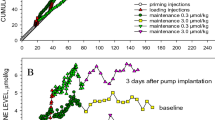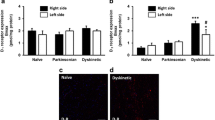Summary
[3H]SCH 23390 is a selective high affinity ligand for D1 receptors in vitro. Using this ligand persistent blockade of D1 receptors by SCH 23390 and cis-flupenthixol was shown to significantly increase the number of D1 receptor binding sites in rat striatum. In contrast, repeated administration of the D2-selective antagonist, clebopride, resulted in a small, but significant, reduction in number. No differences in binding affinity were observed and a single dose of these compounds was without effect. The D2-selective antagonist, haloperidol, the non-selective D1/D2 receptor antagonist, chlorpromazine, the dopamine reuptake inhibitors, bupropion, GBR 12909 and nomifensine, and the dopamine releasing agent, d-amphetamine, had no effect on D1 receptors. The antidepressant treatments, desipramine, zimeldine, amitriptyline, tranylcypromine, mianserin and ECS and the monoamine reuptake inhibitor, sibutramine, similarly did not alter striatal D1 sites. Thus, of the treatments investigated only chronic receptor blockade by high affinity antagonists altered D1 receptor binding in rat striatum.
Similar content being viewed by others
References
Andersen PH (1989) The dopamine uptake inhibitor GBR 12909: selectivity and molecular mechanism of action. Eur J Pharmacol 166: 493–504
Andersen PH, Grønvald FC, Jansen JA (1985) A comparison between dopamine-stimulated adenylate cyclase and3H-SCH 23390 binding in rat striatum. Life Sci 37: 1971–1983
Baldessarini RJ, Frankenburg FR (1991) Clozapine a novel antipsychotic agent. N Engl J Med 324: 746–754
Barkai AI, Durkin M, Nelson HD (1990) Localized alterations of dopamine receptor binding in rat brain by repeated electroconvulsive shock: an autoradiographic study. Brain Res 529: 208–213
Billard W, Ruperto V, Crosby G, Iorio LC, Barnett A (1984) Characterization of the binding of3H-SCH 23390, a selective D-1 receptor antagonist ligand, in rat striatum. Life Sci 35: 1885–1893
Bowden C, Cheetham SC, Crompton MR, Katona CLE, de Paermentier F, Theodorou AE, Horton RW (1994a) Dopamine and its metabolites in depressed suicide victims. Can J Physiol Pharmacol 72(1): T 13.11.26
Bowden C, Cheetham SC, Crompton MR, Katona CLE, de Paermentier F, Theodorou AE, Horton RW (1994b) Dopamine D1 and D2 receptor binding sites in depressed suicide victims. Br J Pharmacol 110: 2P
Cheetham SC, Viggers JA, Slater NA, Buckett WR (1990) Inhibition of [3H]paroxetine binding by sibutramine, its metabolites and other antidepressants correlates with inhibition of [3H]5-hydroxytryptamine uptake. Br J Pharmacol 101: 515P
Cheng Y-C, Prusoff WH (1973) Relationship between inhibition constant (Ki) and the concentration of the inhibitor which causes 50 percent inhibition (I50) of an enzymatic reaction. Biochem Pharmacol 22: 3099–3108
Chipkin RE, Iorio LC, Coffin VL, McQuade RD, Berger JG, Barnett A (1988) Pharmacological profile of SCH 39166: a dopamine D1 selective benzonaphthazepine with potential antipsychotic activity. J Pharmacol Exp Ther 247: 1093–1102
Creese I, Chen A (1985) Selective D-1 dopamine receptor increase following chronic treatment with SCH 23390. Eur J Pharmacol 109: 127–128
De Montis GM, Devoto P, Gessa GL, Meloni D, Porcella A, Saba P, Serra G, Tagliamonte A (1990) Central dopaminergic transmission is selectively increased in the limbic system of rats chronically exposed to antidepressants. Eur J Pharmacol 180: 31–35
Faedda G, Kula NS, Baldessarini RJ (1989) Pharmacology of binding of3H-SCH-23390 to D-1 dopaminergic receptor sites in rat striatal tissue. Biochem Pharmacol 38: 473–480
Fleminger S, Rupniak NMJ, Hall MD, Jenner P, Marsden CD (1983) Changes in apomorphine-induced stereotypy as a result of subacute neuroleptic treatment correlates with increased D-2 receptors, but not increases in D-1 receptors. Biochem Pharmacol 32: 2921–2927
Globus M, Lerer B, Hamburger R, Belmaker RH (1981) Chronic electroconvulsive shock and chronic haloperidol administration are not additive in effects on dopamine receptors. Neuropharmacology 20: 1125–1128
Green AR, Heal DJ, Grahame-Smith DG (1977) Further observations on the effect of repeated electroconvulsive shock on the behavioural responses of rats produced by increases in the functional activity of brain 5-hydroxytryptamine and dopamine. Psychopharmacology 52: 195–200
Heal DJ, Butler SA, Hurst EM, Buckett WR (1989) Antidepressant treatments, including sibutramine hydrochloride and electroconvulsive shock, decrease β1 but not β2-adrenoceptors in rat cortex. J Neurochem 53: 1019–1025
Heal DJ, Czudek C, Buckett WR (1994) Common profile of D1 receptor antagonists and atypical antipsychotic drugs revealed by analysis of dopamine turnover. Prog Neuropsychopharmacol Biol Psychiatry 18: 803–821
Heal DJ, Prow MR, Buckett WR (1991) Effects of antidepressant drugs and electroconvulsive shock on pre- and postsynaptic α2-adrenoceptor function in the brain: rapid down-regulation by sibutramine hydrochloride. Psychopharmacology 103: 251–257
Hyttel J (1983) SCH 23390 – the first selective dopamine D-1 antagonist. Eur J Pharmacol 91: 153–154
Hyttel J (1986) Effect of prolonged treatment with neuroleptics on D-1 and D-2 receptor number in corpus striatum of rat and mouse. Acta Pharmacol Toxicol Copenh 59: 387–391
Hyttel J, Arnt J (1987) Characterization of binding of3H-SCH 23390 to dopamine D-1 receptors. Correlation to other D-1 and D-2 measures and effect of selective lesions. J Neural Transm 68: 171–189
Iorio LC, Barnett A, Leitz FH, Houser VP, Korduba CA (1983) SCH 23390, a potential benzazepine antipsychotic with unique interactions on dopaminergic systems. J Pharmacol Exp Ther 226: 462–468
Jenner P, Marsden CD (1981) Substituted benzamide drugs as selective neuroleptic agents. Neuropharmacology 20: 1285–1293
Kerkman DJ, Ackerman M, Artman LD, MacKenzie RG, Johnson MC, Bednarz L, Montana W, Asin KE, Stampfli H, Kebabian JW (1989) A-69024: a non-benzazepine antagonist with selectivity for the dopamine D-1 receptor. Eur J Pharmacol 166: 481–491
Klimek V, Nielsen M (1987) Chronic treatment with antidepressants decreases the number of [3H]SCH 23390 binding sites in the rat striatum and limbic system. Eur J Pharmacol 139: 163–169
Laruelle M, Jaskiw GE, Lipska BK, Kolachana B, Casanova MF, Kleinman JE, Weinberger DR (1992) D1 and D2 receptor modulation in rat striatum and nucleus accumbens after subchronic and chronic haloperidol treatment. Brain Res 575: 47–56
Lévesque D, Diaz J, Pilon C, Martres M-P, Giros B, Souil E, Schott D, Morgat J-L, Schwartz J-C, Sokoloff P (1992) Identification, characterization, and localization of the dopamine D3 receptor in rat brain using 7-[3H]hydroxy-N,N-di-n-propyl-2-aminotetralin. Proc Natl Acad Sci USA 89: 8155–8159
Lowry OH, Rosebrough NJ, Farr AL, Randall RJ (1951) Protein measurement with the Folin phenol reagent. J Biol Chem 193: 265–275
Martin KF, Needham PL, Atkinson J, Cowan A, Heal DJ, Buckett WR (1988) Rat striatal and mesolimbic D1 receptor binding is not altered by antidepressant treatments including ECS and sibutramine HCl. Br J Pharmacol 95: 896P
Matsubara S, Matsubara R, Kusumi I, Koyama T, Yamashita I (1993) Dopamine D1, D2 and serotonin2 receptor occupation by typical and atypical antipsychotic drugs in vivo. J Pharmacol Exp Ther 265: 498–508
McGonigle P, Boyson SJ, Reuter S, Molinoff PB (1989) Effect of chronic treatment with selective and nonselective antagonists on the subtypes of dopamine receptors. Synapse 3: 74–82
McPherson GA (1983) A practical computer-based approach to the analysis of radioligand binding experiments. Comput Programs Biomed 17: 107–113
Meller E, Bohmaker K, Goldstein M, Friedhoff AJ (1985) Inactivation of D1 and D2 dopamine receptors by N-ethoxycarbonyl-2-ethoxy-1,2-dihydroquinoline in vivo: selective protection by neuroleptics. J Pharmacol Exp Ther 233: 656–662
Modigh K (1975) Electroconvulsive shock and postsynaptic catecholamine effects: increased psychomotor stimulant action of apomorphine and clonidine in reserpine pretreated mice by repeated ECS. J Neural Transm 36: 19–32
Munson PJ, Rodbard D (1980) LIGAND: a versatile computerised approach for characterisation of ligand-binding systems. Anal Biochem 107: 220–239
Nowak G, Zak J (1989) Repeated electroconvulsive shock (ECS) enhances striatal D-1 dopamine receptor turnover in rats. Eur J Pharmacol 167: 307–308
O'Boyle KM, Gaitanopoulos DE, Brenner M, Waddington JL (1989) Agonist and antagonist properties of benzazepine and thienopyridine derivatives at the D1 dopamine receptor. Neuropharmacology 28: 401–405
Paetsch PR, Greenshaw AJ (1992) Effects of chronic antidepressant treatment on dopaminerelated [3H]SCH 23390 and [3H]spiperone binding in the rat striatum. Cell Mol Neurobiol 12: 597–606
Porceddu ML, Ongini E, Biggio G (1985) [3H]SCH 23390 binding sites increase after chronic blockade of D-1 dopamine receptors. Eur J Pharmacol 118: 367–370
Rudorfer MV, Potter WZ (1989) Antidepressants. A comparative review of the clinical pharmacology and therapeutic use of the “newer” versus the “older” drugs. Drugs 37: 713–738
Sharp T, Kingston J, Grahame-Smith DG (1990) Repeated ECS enhances dopamine D-1 but not D-2 agonist-induced behavioural responses in rats. Psychopharmacology 100: 110–114
Stoof JC, Kebabian JW (1981) Opposing roles for the D-1 and D-2 dopamine receptors in efflux of cAMP from rat neostriatum. Nature 294: 366–368
Stoof JC, Verheijden PFHM (1986) D-2 receptor stimulation inhibits cyclic AMP formation brought about by D-1 receptor stimulation in rat neostriatum but not nucleus accumbens. Eur J Pharmacol 129: 205–206
Sunahara RK, Guan H-C, O'Dowd BF, Seeman P, Laurier LG, Ng G, George SR, Torchia J, Van Tol HHM, Niznik HB (1991) Cloning of the gene for a human dopamine D5receptor with higher affinity for dopamine than D1. Nature 350: 614–619
Van Tol HHM, Bunzow JR, Guan H-C, Sunahara RK, Seeman P, Niznik HB, Civelli O (1991) Cloning of the gene for a human D4 receptor with high affinity for the antipsychotic clozapine. Nature 350: 610–614
Von Voigtlander PF, Moore KE (1973) Involvement of nigro-striatal neurons in the in vivo release of dopamine by amphetamine, amantadine and tyramine. J Pharmacol Exp Ther 184: 542–552
Weintraub M, Rubio A, Golik A, Byrne L, Scheinbaum ML (1991) Sibutramine in weight control: a dose-ranging, efficacy study. Clin Pharmacol Ther 50: 330–337
Wielosz M (1981) Increased sensitivity to dopaminergic agonists after repeated electroconvulsive shock (ECS) in rats. Neuropharmacology 20: 941–945
Author information
Authors and Affiliations
Rights and permissions
About this article
Cite this article
Cheetham, S.C., Kettle, C.J., Martin, K.F. et al. D1 receptor binding in rat striatum: modification by various D1 and D2 antagonists, but not by sibutramine hydrochloride, antidepressants or treatments which enhance central dopaminergic function. J. Neural Transmission 102, 35–46 (1995). https://doi.org/10.1007/BF01276563
Received:
Accepted:
Issue Date:
DOI: https://doi.org/10.1007/BF01276563




